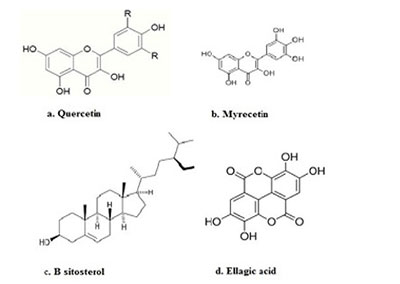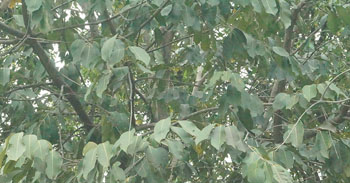KJC Medicinal Garden
Nerale
Syzygium cumini
Order: Myrtales
Family: Myrtaceae
Genus: Syzygium
Species: Syzygium cumini
Common Names: Black Plum, Java Plum
Native to Indian subcontinent, naturalized in America, Africa and Australia
Other plants of the same genus with medicinal properties
-
S. aromaticum
S. aqueum
S. australe
S. curanii
S. corynanthum
S. densiflorum
S. diffusum
S. forte
S. francisii
S. erythrocalyx
- The plant height may reach 30 m, and is 11 m broad.
- Bark is rough and cracked, trunk diameter is 0.6 – 0.9 m
- Leaves have a turpentine smell, pinkish in youth and yellowish when matured.
- Flowers are fragrant, white and first and then become rose pink.
- Fruits appear in clusters of 10-40 round and curved which turn to dark-purple on maturation.
- The pulp is white or purple and very juicy
Uses in Tradition systems of medicine
- It is used in Indian Ayurvedic medicine for treatment of Diabetes mellitus.
- In Unani medicine it is used to enrich blood, strengthen teeth and gums.
- The black plum relieves stomach pain, carminative, anti-scorbutic and diuretic.
- Black plum vinegar reduces enlargement of spleen, diarrhoea.
- It is the medium of purifying blood and hence good for the skin and beauty.
- It also enhances the immune system.
- It is rich in Vitamin A and Vitamin C
- Minerals – Iron
- Protein – 0.70-0.13 g, 14.00 – carbohydrate, 8.30-15.00 g calcium, 15.00 – 16.20 g phosphorous, 0.15-0.30 g fat, 1.20-1.62 mg Iron, 90 I.U. vitamin A.
Suggested Medicinal Properties
- Anticancer
- Anti-inflammatory
- Cardioprotective
- Hepatoprotective
- Antidiabetic
- Antioxidant
- Anti-diarrhoeal
- Anti-microbial
- Antihistamine
- Anti-fertility
- Gastroprotective
Active Phytochemicals
1. Stem Bark contains ß-sitosterol-D-glucoside, Kamepferol-3-0- glucoside, quercetin, myricetin, astragalin, and gallic acid.

2. Fruit contains Malic acid and small quantity of oxalic acid. Cyanidine and Diglycoside imparts the purple color.
3. Seed consists of glucoside jamboline, a new phenolic substance
4. Leaves have essential oil such as terpenes, 1-limonene and dipentene
5. Flowers contain Kaempferol, quercetin, isoquercetin.
6. Roots contain myricetin 3-o-ribinoside
7. Fruits are rich of raffinose, glucose, fructose, citric acid, and mallic acid
8. Isoquercetin (quercetin-3-glucoside)
9. Isorhamnetin 3-O-rutinoside
10. Myricetin-3-L-arabinoside
11. Malvidin-3-glucoside
12. Petunidin-3-glucoside
13. They also contain alkaloids, flavonoids, glycosides, steroids, phenols, and tannis
References
Bijauliya RK, Alok S, Sabharwal M and Chanchal DK: “Syzygium cumini (Linn.) - An overview on morphology, cultivation, traditional uses and pharmacology.” Int J Pharm Sci & Res 2018; 9(9): 3608-20. doi: 10.13040/IJPSR.0975-8232.9(9).3608-20
“Morphology, Phytochemistry and Pharmacology of Syzygium Cumini (Linn.) – An Overview | International Journal of Pharmaceutical Sciences And Research,” May 31, 2017. https://ijpsr.com/bft-article/morphology-pytochemistry-and-pharmacology-of-syzygium-cumini-linn-an-overview/

